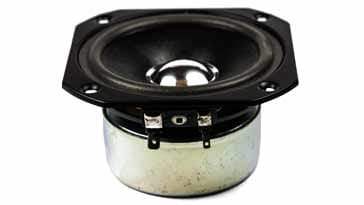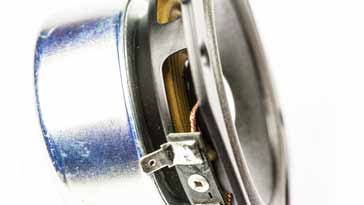Moving Coil Loudspeaker
Details of the moving coil loudspeaker or moving coil speaker.
Loudspeaker Tutorial Includes:
What is a loudspeaker: basics
Moving coil loudspeaker
Loudspeaker enclosures
Loudspeaker repairs
Speaker wire / cable
Additional moving coil loudspeaker topics:
Doppler distortion
Speaker cones
Speaker cone resonance
Speaker coil
The moving coil loudspeaker is the most widely known and used form of loudspeaker. It can be found in many electronic items from radios to Bluetooth speakers and in public address systems - in fact anywhere that electrical waveforms need to be turned into audible sound.
The moving coil loudspeaker performs well and is able to be manufactured relatively easily. However, like all transducers converting electrical waveforms into sound, its operation can be complex as the moving coil loudspeaker links electrical and mechanical domains.

Moving coil loudspeaker basics
The moving coil loudspeaker uses the magnetic effect generated by a flowing current as the basis of its operation.
When a current flows in a wire, a magnetic field appears around it. When the wire is wound into a coil, the effect is increased.

If the coil is placed into a steady magnetic field created by a fixed magnet, then the two magnetic fields will interact. Opposite poles attract and like poles repel. This means that the current flowing in the coil can cause the coil to be attracted or repelled from the fixed magnetic field - the degree of the force being proportional to the current flowing.
If the coil is attached to a large diaphragm, then the sound waves will be more effectively transferred to the air.
This is the basic concept of the moving coil loudspeaker.
Video: Understanding Loudspeakers: what they are, how they work
Moving coil loudspeaker construction
The construction of moving coil loudspeakers follows a fairly standard format, although there are major differences in the electrical and mechanical dimensions and parameters, as well as the materials used..

- (1) Magnet: The magnet provides the fixed magnetic field against which the field from the coil operates. The magnet is typically made from ferrite or powerful neodymium.
- (2) Chassis / frame : The moving coil loudspeaker is generally built on a circular frame - occasionally these may also be elliptical. The frame forms the basis for the loudspeaker and provides its structure, although it does not perform any active part in the operation.
- (3) Diaphragm or cone: At the front of the moving coil loudspeaker there is a cone or diaphragm. This transfers the vibrations of the moving coil to the air, presenting a large surface area. The loudspeaker diaphragm can be made of fabric, plastic, paper, or lightweight metal. The outer part of the diaphragm is fixed to the rim of the frame - the extremity of the diaphragm often having some undulations to enable the main part to vibrate easily.
- (4) Diaphragm undulations: The diaphragm undulations enable the main part of the diaphragm to move freely and in a linear fashion.
- (5) Dust cap (dome): This part of the moving coil loudspeaker protects the voice coil from dust and dirt.
- (6) Voice coil & former: The moving coil is the key element of the loudspeaker. It takes the current from the audio amplifier and the current flowing generates a magnetic field which interacts withat from the permanent magnet and this creates a force which moves the coil and hence the diaphragm to which it mechanically attached creating the sound waves.
- (7) Spider (suspension): This is a flexible, corrugated support that holds the voice coil in place, while allowing it to move freely. It is not present on some lower end loudspeakers, but provides a very useful support ensuing the coil is properly centred. Normally the space around the coil is limited to enable the maximum efficiency to be maintained and the coil needs to be free from touching the adjacent magnet. If it does touch, it causes a rasping sound to be heard as the loudspeaker coil moves in and out.

Moving coil loudspeaker considerations
When designing and when using a moving coil loudspeaker, it is useful to be aware of some of the design limitations, trade-offs and issues.
- Doppler distortion: It is found that when a loudspeaker is reproducing both high and low frequency notes, the movement caused by the low frequency tone can result in the Doppler effect being present on the high frequency tone.
Read more about . . . . Moving Coil Speaker Doppler Distortion.
- Cone construction: The design of the cone of diaphragm is a difficult compromise. The cone needs to be rigid, whilst also having a low mass. Cone flexure can cause distortion of the signal so a rigid construction is needed. A low mass is also needed to minimise inertia so that the loudspeaker can respond accurately to changes in the sound. Fortunately new materials have assisted in improving performance in recent years.
Read more about . . . . Speaker Cone / Diaphragm.
- Cone suspension: The way in which the cone or diaphragm of the moving coil loudspeaker is suspended has a significant impact on its operation. The suspension needs to maintain the alignment of the cone, whilst also ensuing free movement in and out. The centring of the coil is also ensured on many loudspeakers by the use of an additional suspension near the coil. Older speakers used what was termed a spider across the front of the coil that was secured by a screw to the pole piece. This enabled manual centring of the speaker should it ever go out of alignment.
- Cone resonance: The cone resonance frequency is often quoted in loudspeaker specifications. Output drops at a rate of 12 dB per octave below this, so the lower the cone resonance the better the bass response.
Read more about . . . . Loudspeaker Cone Resonance.
Moving coil loudspeakers are precision pieces of mechanical and electrical engineering. There is a balance between many conflicting requirements, but the results from a good loudspeaker can sound really outstanding.
 Written by Ian Poole .
Written by Ian Poole .
Experienced electronics engineer and author.
More Audio Video Topics:
HDMI
SCART
DisplayPort
DVI
Loudspeaker technology
Headphones & earphones
Bluetooth speakers
Stereo sound
Microphones
Audio compact cassettes
Vinyl record technology
Digital radio
DVB television
Return to Audio / Video menu . . .


